
Home About Us Contact Us Subscribe

Home About Us Contact Us Subscribe
|
|
|
|
Riverside Reveries: The Museum of Life and the Environment by William McDonough + Partners; Ralph Appelbaum Associates; and Nelson-Byrd Landscape Architects
York County, South Carolina: A riverbank with ancient fish weirs and giant oaks inspires a "living museum." by Kristen Richards May 6, 2002 Editor’s note: A special session on
Green Museum Design has been added to the AIA National Convention program: William
McDonough, FAIA, Principal, and Christopher Hays, AIA, Design Partner, will
present this project on Friday, May 10, 12-1 pm, in Room
203B at the Charlotte Convention Center. The program will follow the
lecture by Hugh L. McColl, Jr., the former president of Bank of America and a
major sponsor of the museum. What
is a "green museum?” Given that fresh air and abundant daylight
potentially contradict the goals of traditional black-box exhibit space, in
which the visitor is immersed completely in the subject matter on display, is a
"sustainable" museum even practical? The Museum of Life and the
Environment, the first museum project by William McDonough + Partners (WM+P),
addresses this challenge. Located on the shore of the Catawba River in York
County, South Carolina, the museum will explore the relationships between
culture and nature, people and place, by focusing on the heritage of the Carolina
Piedmont and other demonstrative environments around the world. The museum is being designed as a close collaboration between WM+P, Ralph Appelbaum Associates, and Nelson-Byrd
Landscape Architects. The architecture and its systems will operate in conjunction
with the landscape and exhibits as a unified illustration of the museum's
themes and principles, demonstrating natural processes in a living
architecture. The conceptual design has just been completed for the
120,000-square-foot project that will include 40,000 square feet of exhibit
space, scheduled to open in 2005. Located 30 minutes south of
Charlotte, North Carolina, the site – an undeveloped 400-acre lot – offers a
unique opportunity to reconnect the local community to the river, the original
reason for settlement in the area. (The property was donated to the York County Culture and
Heritage Commission in 1998 by Jane McColl, wife of former Bank of America
Chairman Hugh McColl, Jr.; the museum itself will take up about 40 acres.) The existing landscape offers dramatic spaces and
views, particularly the area surrounding the stream between the island and the
north bank, where the museum is sited. The rushing water and the densely
vegetated island create a cool, quiet, protected oasis, and the architecture
and landscape are being developed to dramatize this space through a series of
interior and exterior spaces lining a necklace-shaped pathway. The progression
through the site is one of discovery – from the entry road, the porous-paved
parking terraces, the entrance court, the building itself, the interior
exhibits, and the gardens below, through to the island beyond. Raised
boardwalks become bridges allowing visitors to cross to the island. The building and primary
gardens are sited just above the 100-year flood plain; the eroded bank where
the floods occur may actually be part of the outdoor exhibits. Generally, over
the course of any given day, the water level varies by 3-5 feet or so, rising
and falling with the release of water from the Lake Wylie dam to the north. The museum entrance will be
located at the top of the steep riverbank, offering a spectacular view of the
stream, island, and river. Woven carefully into the existing topography, the
building will spring from the crest of the hill. From the approach side, most
of the building is below the visitors’ view, nestled into the slope. Grass
roofs unite the top of the building with the adjacent meadow, and native
endangered sunflowers will be allowed to grow on the roofscape. The sod roof also
thermally protects the building, changes with the seasons, provides habitat,
creates oxygen, and sequesters carbon, so that it contributes to a humane
environment and an architecture that is basically seamless with the land. According
to a report in The Herald (the daily paper for York and Chester counties) on
WM+P’s presentation to museum representatives, engineers, and architects
earlier this year, lead architect William McDonough said: "You just walk
into a meadow, and all of a sudden, it's a building." From below, the building
spreads along the arc of the hill, jogging around principal trees that are to
be preserved. The orientation of the building allows ample daylight on the
south side (facing the river), and the roof is serrated to bring soft light
into the heart of the building. The interior is stratified with gradations of
light and space. The north galleries are fully buried in the hillside,
completely enclosed and protected from light. Light-sensitive artifacts will be
housed there. The middle gallery, where light is diffused along the ceiling, is
a double-height nave-like space where freestanding exhibit installations will
be accessed by catwalks and perimeter walkways. The south galleries are filled
with light and air and unobstructed views and access to the gardens outside.
Here, meditative exhibits will illustrate abstract themes – for instance, the
“earth room” may consist of nothing but a soil floor and/or a single tree, and
the “water pavilion” may be an interior pool. These interior thematic galleries
will relate to the exterior gardens, so the exhibit continues into the
surrounding landscape, where wildlife gardens, biological treatment ponds, and
fish-viewing chambers serve as educational tools. On the island, a “wind
pavilion” constructed of wood pipes will capture breezes off the river to
create harmonic sounds – the tower will be a visual and aural culmination of
the museum experience. The various disciplines and
building systems all express the project’s themes. Heating and cooling will
occur through a radiant floor system that works with the mass of the earth and
the coolness of the water to regulate temperature, so the mechanical system
will illustrate how the building integrates with the surrounding landscape.
Photovoltaics demonstrate the use of solar energy to power the building.
Exterior sunshade materials are being studied to react to varying temperatures
and solar angles, so the glazing system capitalizes on the natural tendency of
materials to expand and contract. The primary structural walls, which radiate
through the arc of the building’s plan, are composed of custom concrete blocks
measuring approximately 3-by-5 feet. Exposed throughout the building, the
hollow blocks will convey air, supplementing the radiant floors with ventilation.
These walls will extend northward from the building into the landscape, forming
bench-height garden walls, furthering the impression that the museum is
extruded from the hill. Gently curved at the top to
follow the profile of the hill, these stone-like walls echo the ruins of fish
weirs in the stream below. Left by unidentified ancient peoples, the weirs are
estimated to be as much as 5,000 years old. Given that the more recent historic communities
entered the region no earlier than 500 years ago, the sense of time evoked by
these ruins is unfathomable. “They suggest an epochal scale,” says project
architect Lance Hosey, AIA. “For us, the weirs are a
powerful illustration of the interaction between humanity and nature, so they
provide a perfect metaphor for the project. The building's form, materiality,
and relationship to the landscape are inspired by these simple structures.” McDonough
characterizes the new building as a “living museum” and a "legacy to
future generations. It will be more productive than destructive, and will offer
a message of hope to young people." Owner: York County Culture & Heritage Commission, Rock
Hill, SC; Van Shields, Director Architect: William McDonough + Partners, Charlottesville, VA Team: William McDonough, FAIA (Principal), Christopher Hays,
AIA (Design Partner), Lance Hosey, AIA (Associate/Project Architect) Exhibit Design: Ralph Appelbaum Associates, New York City Team: Ralph Appelbaum, Scott Simeral, Evelyn Reilly Landscape Architecture: Nelson-Byrd Landscape Architects,
Charlottesville Team: Susan Nelson, Warren Byrd, Kennon Williams Structural: Guy Nordenson and Associates, New York Mechanical: Flack + Kurtz, New York Area: 120,000 gross square feet; 40,000 square feet of
exhibit space Spring 2002: completion of conceptual design 2005: construction completion Founded in 1981, William McDonough + Partners is an
internationally recognized firm of architects, planners, and leaders in sustainable
design, and has received wide acclaim for giving vital aesthetic form to
innovative models of ecologically intelligent architecture and planning.
Projects frequently serve as a benchmarks for those in search of a sustaining
design agenda both in the United States and around the world. The firm’s
portfolio of design and planning work for large corporate campuses, academic
institutions, and communities, as well as individuals and families, includes
milestones of the sustainable design movement. The firm moved from New York
City to Charlottesville, Virginia, in 1994, upon Mr. McDonough's appointment as
Dean of the School of Architecture at the University of Virginia. Ralph Appelbaum Associates are planners, designers,
and producers of award-winning museum exhibitions, visitor centers, and
educational environments. Subject areas range from natural history and the
physical sciences, to cultural, social, and corporate history, to sports and
the fine arts, with over 90 projects in the corporate portfolio. Notable
projects include: the U.S. Holocaust Memorial Museum, Washington, DC; Intel
Museum, Santa Clara, California; Museum of African-American History, Detroit;
Hall of Biodiversity and Rose Center for Earth and Space, which are part of the
American Museum of Natural History, New York City; and the Corning Museum of
Glass, Corning, New York. Susan
Nelson-Warren Byrd Landscape Architect's philosophy centers around honoring the local historic and natural contexts of an individual site. The firm is known for employing a palette and vocabulary of primarily indigenous materials, including plants, paving details, landforms, and waterworks. Their work melds the particular – a place, a plant community, a certain landform – with the universal – archetypal forms such as the mount, the theater, the grove, the parterre, and spatial concepts of prospect and refuge – so that the local ethos of a place is never lost or homogenized. Through the use of appropriate design strategies, Nelson-Byrd attempts to be particularly responsive to environmental considerations of storm water retention, wildlife attraction and energy conservation. Their projects include botanic gardens and arboreta, such as the Center for Sarah P. Duke Gardens, corporate and institutional work, and private residences and gardens. |
(click on pictures to enlarge) 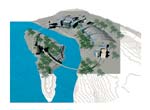 (William McDonough + Partners (WM+P)) A massing study for the Museum of Life and the Environment on the banks of the Catawba River in South Carolina.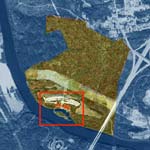 (WM+P) Aerial of site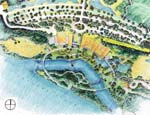 (Nelson-Byrd Landscape Architects) Site plan (WM+P) Model (WM+P) Museum entry courtyard (WM+P) Section of entry courtyard (WM+P) Lobby perspective (WM+P) Exhibit wing perspective (WM+P) Exhibit wing section (WM+P) West concourse (WM+P) East concourse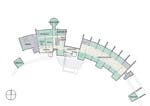 (WM+P) Lower level plan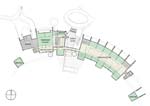 (WM+P) Upper level plan |
© 2002 ArchNewsNow.com